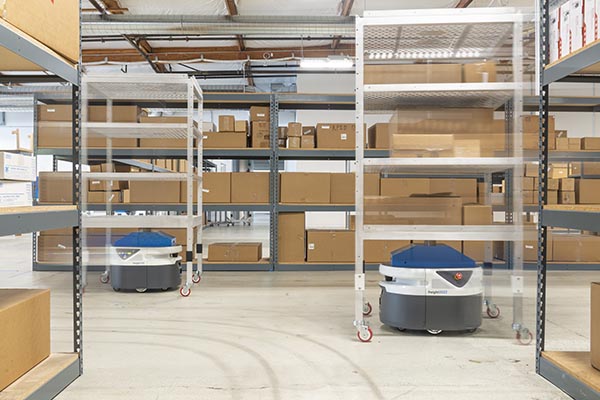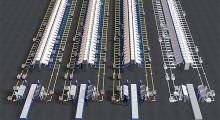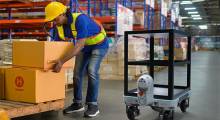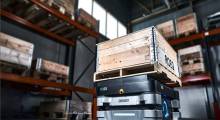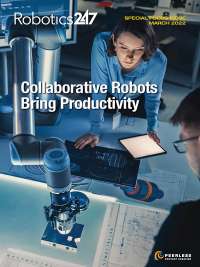Bob Wallace, distribution center manager at Top Notch Distributors Inc.'s Mansfield, Mass. warehouse, was excited when he heard the company was going to be installing 6 River Systems mobile robots at his facility.
He is always open to trying new technologies, and Top Notch had already installed 6 River Systems' Chucks at other distribution centers throughout the U.S.
“I like technology and change,” he told Robotics 24/7 during a recent site visit to the facility. “I remember when there was no computers, and we used paper, but I’ve been through a lot of changes, and they all turned out to be extremely good. I always look at them with an open mind.”
Autonomous mobile robots, or AMRs, are used in the warehouse industry for put-away, picking, replenishment, and sorting. They are designed to work alongside humans to make their jobs more efficient.
They are part of a rising trend in warehouse-industry automation. Companies are turning to robots to help them keep up with rising e-commerce demands, labor shortages, and to extend the life of their facilities.
AMR sales on the rise
Last month, Interact Analysis reported that more than 100,000 mobile robots were deployed globally last year, which it said is the first time that milestone has been met.
“The current labor shortage, coupled with strong e-commerce growth, has accelerated manufacturing and logistics companies’ plans to automate,” wrote Ash Sharma, managing director at Interact Analysis and the author of the report. “This has caused sales in mobile robots to spiral, with nearly 70% more vehicles shipped than the year before and a 36% increase in revenues, which rose to nearly $3 billion.”
AMRs are smart because they take advantage of technologies such as sensors, cameras, artificial intelligence, machine learning, and more to understand, adapt, and move around their environments.
Top Notch increases volume with Chuck
Since January, the door hardware company has been using eight Chucks at its Mansfield facility.
Top Notch is already seeing the benefits of the robots it bought.
“We’ve added volume to the point that this is the second biggest volume site for us,” said Patrick Houlihan, director of operations at Top Notch. “But we have not added people. We have been able to use technology to keep up with our growth.”
Warehouse picker Joey Montville has worked for Top Notch the past 26 years.
In the few months he has been using the company’s AMRs, he has gone from completing about 400 lines a day to about 700. It depends on how many items the facility receives each day, according to Wallace. Even during days when the company receives fewer orders, workers are completing more lines with the AMRs than before.
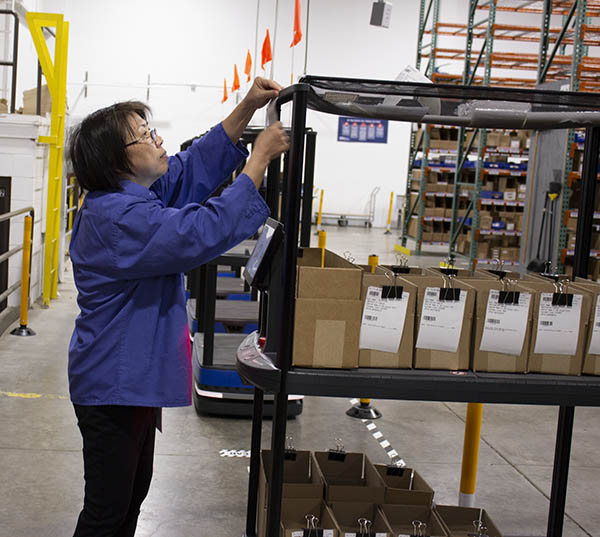
Montville is also doing less manual labor. The 6 River Systems Chucks have helped cut down on the amount of walking he needs to do in a day and have overall made his job easier. The robots’ touchscreens help confirm the type of items and quantities that need picking more easily than their older systems, he said.
“They are much more effective because the other way we used to pick was with papers,” he said.
Chucks can also carry payloads of up to 200 lb., much more than the average worker.
AMRs easier to deploy and scale
Research firm IDTechEx found that there are several factors for the AMR rise, including their easy deployment and scalability, their relatively low onboarding costs, return on investment, and their benefits over fixed automation, such as conveyor systems and automated storage shuttles.
Since May 2021, Waytek has been using three AMRs from Fetch Robotics, now part of Zebra Technologies, at its 100,000-sq.-ft. facility in Chanhassen, Minn.
Founded in 1970, Waytek is an electrical components distributor of wire, fasteners, connectors, battery management, and other products used in specialty vehicles and mobile equipment.
In 2020, the company realized the conveyor system it had been using since 2007 wouldn’t be able to keep up with demand in the future, according to Mike Larson, co-owner and chief operating officer at Waytek.
“We had a fixed capacity of our existing conveyor system,” Larson told Robotics 24/7. “At that point, we were having a good number of days where we would be shipping 800 plus orders. So, we really had to take a hard look and say, ‘How are we going to both sort out our orders as well as convey the goods around the facility.’”
To solve the issue, the company took a two-pronged approach, he said. It invested in three AMRs and put up two put walls to help them sort their orders.
The put walls allowed the company to replace the sortation feature it used in its conveyor system. The AMRs helped replace what the conveyor system did, which was bring the goods from pickers to the shipping area for sortation, he said.
The AMRs are being used for three specific workflows, according to Fetch Robotics. (See video above.)
Every 15 to 20 minutes, the AMRs take the goods from the pick stations and bring them to the put walls. Secondly, the AMRs are used to transport goods from the receiving and replenishment area to two of the facility’s pick stations. Thirdly, they are used for trash and debris removal.
Since removing the conveyor system, Larson said the company has been able to regain 10,000 sq. ft of racking space to store goods. Larson also estimated that Waytek will now be able to stay in the facility for an additional five years.
“Where our conveyor could only allow us to handle up to 800 orders a day, now with AMRs, we can add additional routes and pickup times,” Larson said in the video. “We’ll be able to handle well over a thousand orders a day. Once we get to a point where we need to add more orders than that, we could easily add another AMR. We don’t need to remap the entire facility.”
E-commerce boom continues
Stefan Nusser, Fetch Robotics' chief product officer, said the rise in e-commerce orders during the early days of the pandemic has helped accelerate AMR demand.
“When the pandemic started, there was this spike in e-commerce activity,” Nusser said. “People were locked up at home. They were doing e-commerce orders. Everyone who was involved in running a warehouse had a sudden spike of activity. And that hasn’t changed to this day—even though the world has reopened. My impression is that people who used to shop in stores that got locked in got used to ordering online.”
With volumes going up, so does the need for efficient operations. Combined with tight local labor markets, companies say they need fast solutions yesterday.
“Most customers I talk to today are scrambling,” Nusser said. “I'm not talking to people who are sitting there with a spreadsheet and spending weeks and months building an investment case about what they are going to do next year or the year after.”
“I'm talking to customers who are very visibly worried, saying, 'Look, I'm working at my limits. My team is working at its limits. It's April, and I know in October, my volume is going to start spiking again. I need something between April and October that's going to help me.' That's a very diffficult conversation,” he added.
.jpg)
AMRs offer a solution because they are flexible, can adapt to exisiting workflows and facilities, and can be deployed quickly, he said.
On average, a self-contained deployment of the company's AMRs only takes about three days, he said.
Nusser said warehouses often measure success by the efficiency of their human pickers.
“This is measured by units per hour or lines per hour,” he said. “The actual values are hard to compare because it depends on your order profile, the layout of your warehouse, but that is the metric our customers care about the most – how many orders or how many units can I pick in an hour, or a given timeframe.”
AMRs are being designed to work within companies’ warehouse management systems, he said. Within those systems, the robots are assigned specific tasks alongside humans.
“The collaboration between the robot and the worker is changing,” he said. “It is almost like the robot is guiding the worker about what work needs to be done.”
Expanding interoperability
Jan Nicolay, global account director of logistics at Mobile Industrial Robots (MiR), said the company has been able to take advantage of 5G technology to expand the coverage area of its AMRs. No longer will customers need to rely solely on Wi-Fi to get their robot to operate properly.
“All the sites we are going into do, of course, have Wi-Fi, but often when we do a site audit, we do identify some areas where the coverage is slow or the signal is weak. Therefore, 5G is really an enabler to have higher throughput, better connection. It has huge potential later on to do cloud-based solutions.”
To help expand interoperability between AMR vendors, the company, along with Vecna Robotics, 6 River Systems, Waypoint Robotics, Locus Robotics, Seegrid, MiR, AutoGuide Mobile Robots, Third Wave Automation, A3, and Open Robotics, is part of MassRobotics' AMR Interoperability Working Group.
“Going two or three years back, an installation of two or three AMRs was really the standard,” Nicolay said. “You saw a lot of customers started with small fleets just to test the technology.
“But these days, you have installations of multiple robots—20, 30, and beyond— and not only from one vendor, but from multiple vendors for different applications, different use cases,” he added. “There really is a demand for a single internal logistics system.”
The company has an ROI Calculator on its website to help customers determine how its mobile robots may help companies save money, increase productivity, and save resources.
About the Author
Follow Robotics 24/7 on Linkedin
Article topics
Email Sign Up

